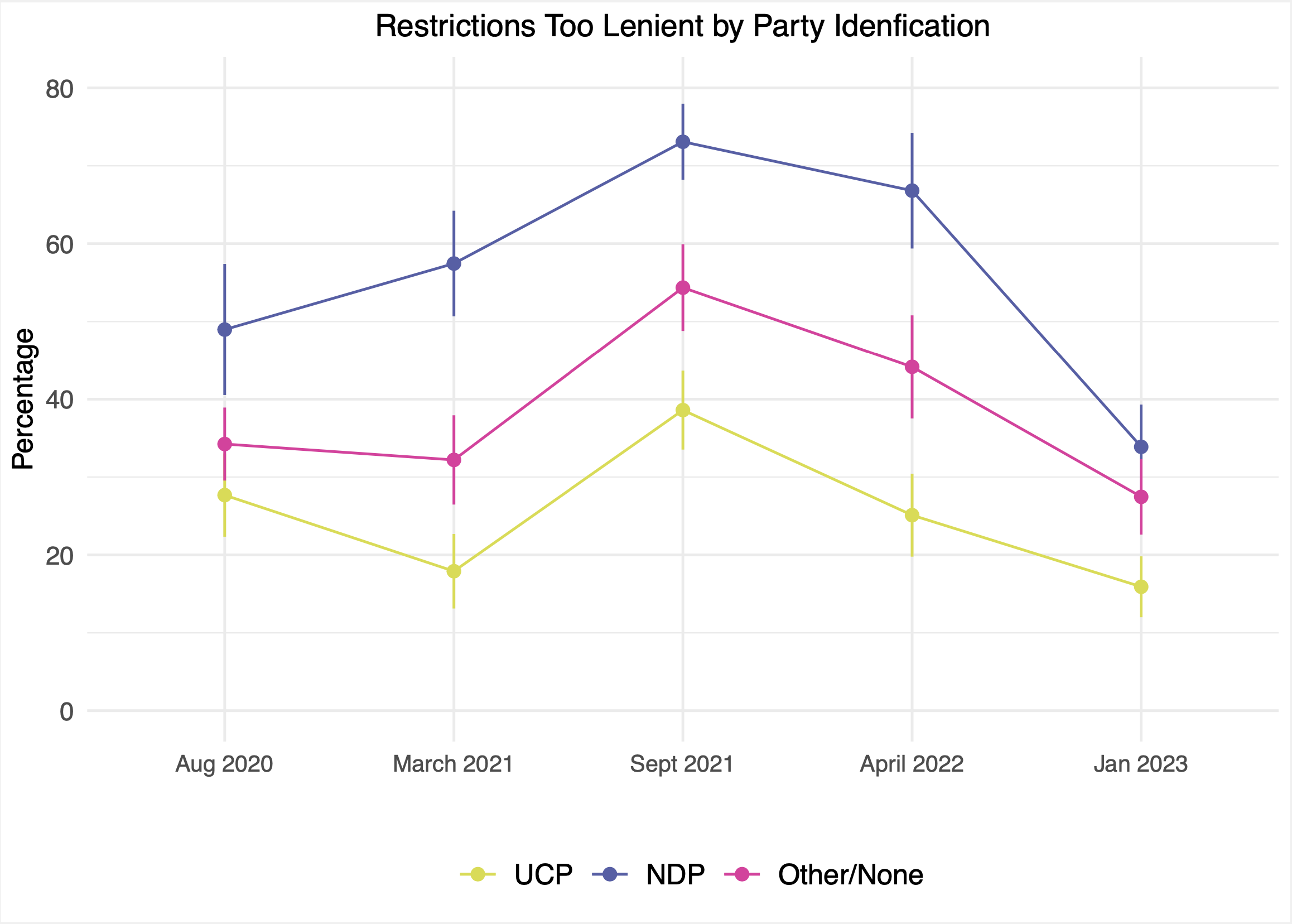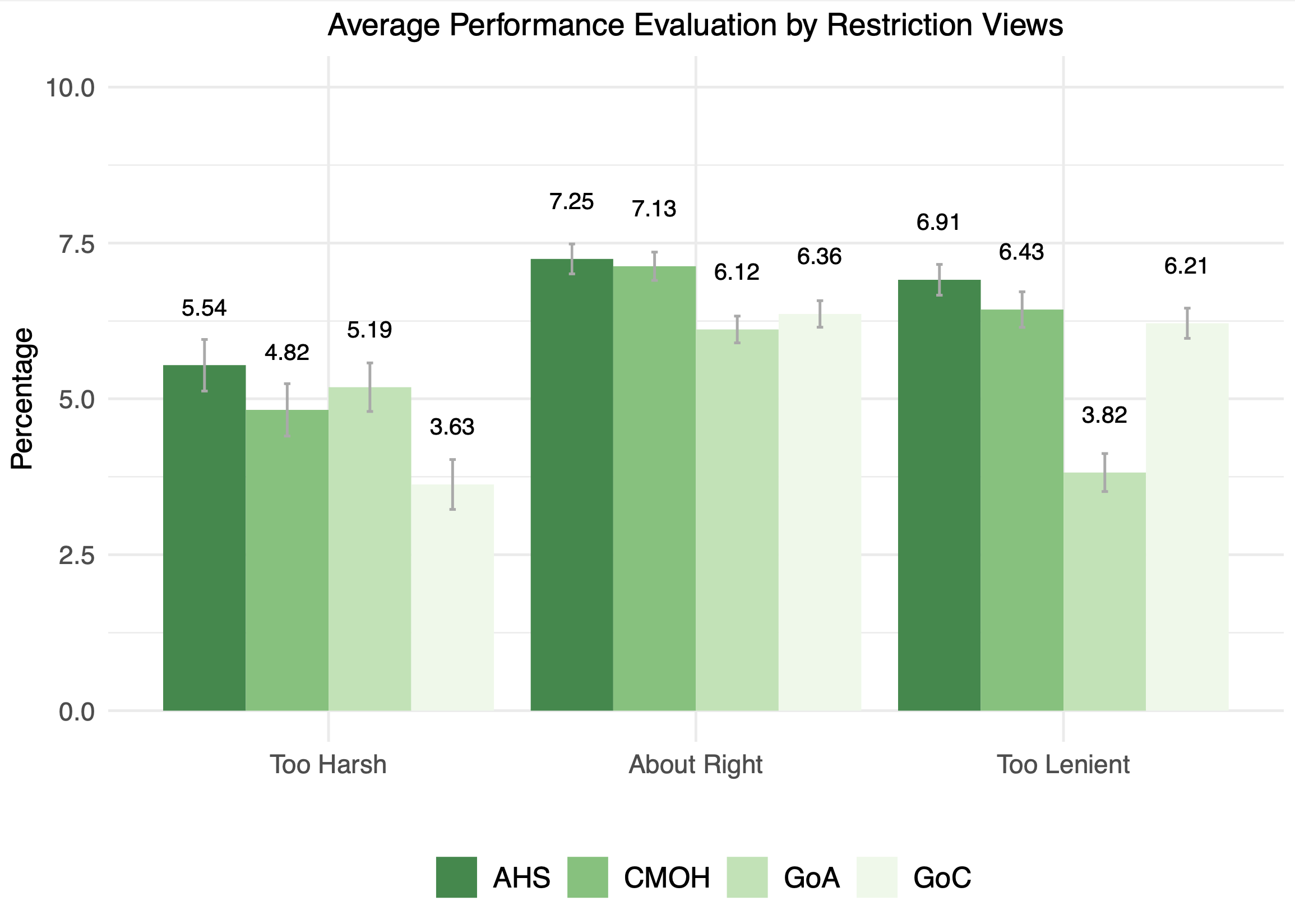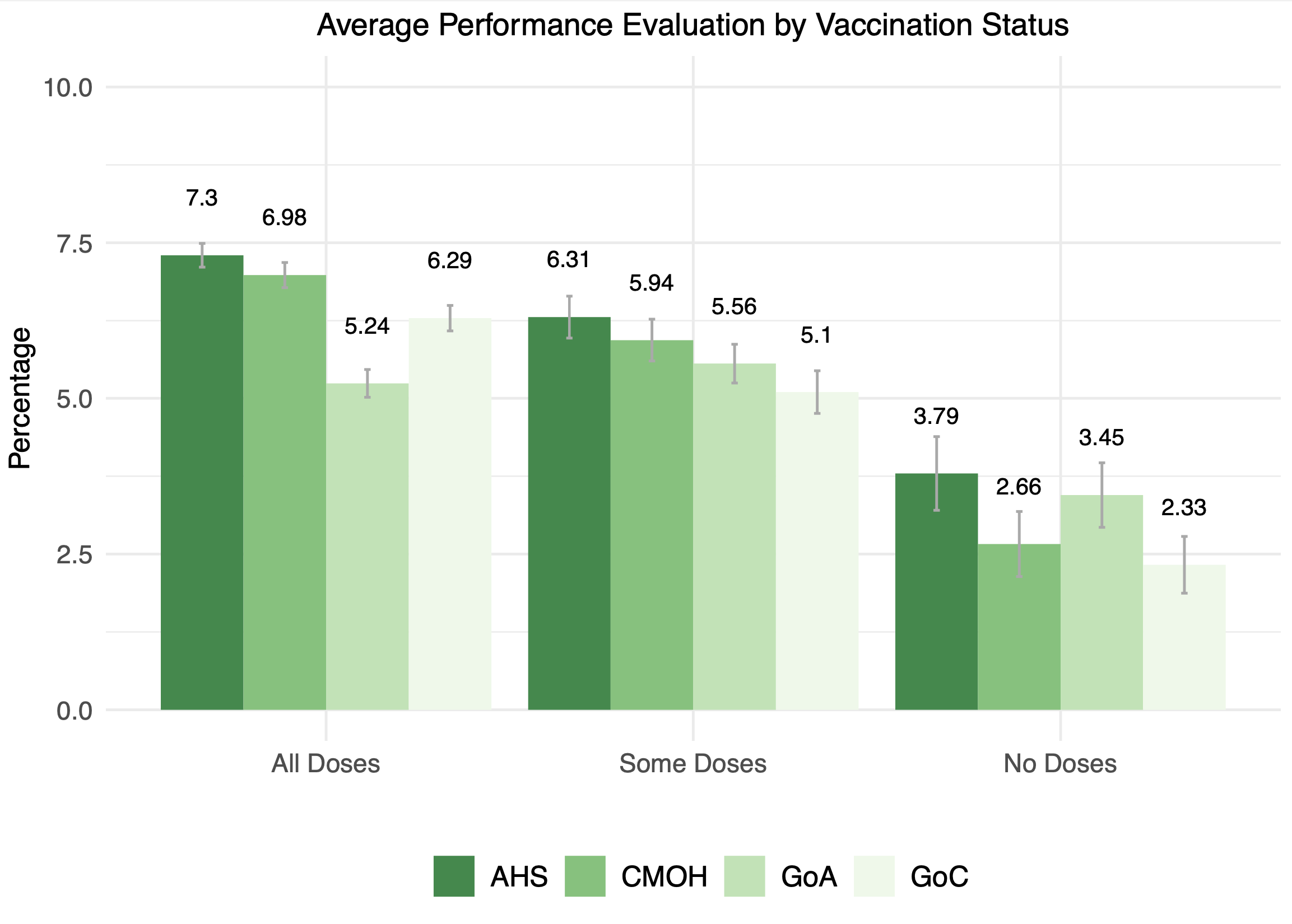The evolution of Albertans' attitudes about COVID-19 restrictions
Lisa Young | University of Calgary | lisa.young@ucalgary.ca
Michelle Maroto | University of Alberta | maroto@ualberta.ca
March 15, 2023
Looking Back on Alberta’s Pandemic Response
When the World Health Organization declared COVID-19 a pandemic on March 11, 2020, governments everywhere scrambled to respond. Like many other jurisdictions, Alberta’s initial response was to put in place non-pharmaceutical measures, including closing schools, mandating work from home when possible and requiring social distancing in public places like grocery stores. Over the next three years, the question of what public health measures the Government of Alberta should employ in response to the pandemic became a contentious issue within the province’s politics.
This brief draws on five Alberta Viewpoint surveys, from August 2020, March 2021, September 2021, April 2022, and January of 2023 to examine the evolution of Albertans’ assessments of the province’s COVID response over the three years of the pandemic. The January 2023 survey included several questions asking respondents to reflect back over the three years of the pandemic, offering insight into their retrospective views on the province’s pandemic response and performance of various players in that response. The brief also examines Albertans’ views about who should make decisions about pandemic responses.
Evolving Views on Pandemic Restrictions
Over the three years of the COVID-19 pandemic, Albertans were often divided about what approach the government should take, with some advocating for more stringent measures and others arguing that the measures in place were too harsh. The measures in place varied over the course of the pandemic, ranging from significant closures in March of 2020 to the lifting of virtually all restrictions in March of 2022.
In August of 2020, the Viewpoint Alberta survey included this question: “Alberta has opened up activities and businesses such as parks, gyms, restaurants, workplaces, and retail establishments. Do you feel that this process of opening up is happening too quickly, too slowly, or just about right?” The majority of respondents – 55% – indicated that they felt the pace was “about right.” Another third – 34% – felt the pace was too quick. Only 10% felt the pace was too slow. Although the question wording was different, it is included for comparison in Figure 1.
In March of 2021, when vaccinations were just becoming available and there were significant public health restrictions in place, over one-quarter of survey respondents thought Alberta’s pandemic measures were too harsh, while another one-third thought they were too lenient. In September of the same year, as the provincial health system grappled with the Delta variant and vaccination and mask mandates were put in place, 17% thought measures were too harsh, while 55% thought they were too lenient. In April of 2022, when most measures had been removed, 12% maintained that measures were too harsh and 42% said they were too lenient. In January of 2023, with no government-mandated measures in place, 15% indicated pandemic restrictions were too harsh and 26% too lenient.
It was only at the end of the first wave of the pandemic, when measures were being relaxed, and in January of 2023, when most measures had been removed for almost a full year, that a majority of respondents thought the measures in place were “about right.” A consistent one-quarter to one-third of respondents thought measures were too lenient (or being removed too quickly), even in January of 2023. The proportion who thought the measures were too harsh (or being removed too slowly) was at least 10%, and ranged as high as 26% in March of 2021.
The January 2023 survey also asked respondents to reflect on measures in place over the course of the entire pandemic. One-quarter of respondents indicated measures had been too harsh, while slightly more (31%) said they were too lenient. Although they disagreed on the direction, the majority of respondents thought the provincial government ‘got it wrong’ in its approach to pandemic management.
Figure 1: Views of Pandemic Restrictions, August 2020 - January 2023
SOURCE: AB Viewpoint Surveys - Aug. 2020 (N = 812), March 2021 (N = 802), Sept. 2021 (N = 1204), April 2022 (N = 811), Jan. 2023 (N = 1227)
NOTES: Estimates based on weighted survey data. Question wording varies across years. Aug. 2020: “Alberta has opened up activities and businesses such as parks, gyms, restaurants, workplaces, and retail establishments. Do you feel that this process of opening up is happening too quickly, too slowly or just about right?” March 2021, September 2021, April 2022, January 2023: “Thinking about the rules in place right now, are COVID-19 restrictions in Alberta too harsh, too lenient, or just about right?
In Alberta, as in many other jurisdictions, partisan affiliation was associated with different attitudes toward pandemic restrictions. Figure 2 shows those who identify with the NDP were more likely to see the pandemic restrictions as too lenient, (or opening happening too fast in August of 2020), while those who identify with the UCP were less likely to do so. Survey respondents who do not identify with a party fall in the middle between the partisan identifiers.
Figure 2: Pandemic Restrictions “too lenient” (opening too fast) by Party Identification
SOURCE: AB Viewpoint Surveys - Aug. 2020 (N = 812), March 2021 (N = 802), Sept. 2021 (N = 1204), April 2022 (N = 811), Jan. 2023 (N = 1227)
NOTES: Estimates based on weighted survey data. Question wording varies across years. Aug. 2020: “Alberta has opened up activities and businesses such as parks, gyms, restaurants, workplaces, and retail establishmentRs. Do you feel that this process of opening up is happening too quickly, too slowly or just about right?” March 2021, September 2021, April 2022, January 2023: “Thinking about the rules in place right now, are COVID-19 restrictions in Alberta too harsh, too lenient, or just about right?
Similarly, those who located themselves to the left of center politically were substantially more likely to say the pandemic response was too lenient, while those to the right were substantially more likely to say the response was too harsh (Figure 3).
Figure 3: Left-Right self-placement by retrospective views of pandemic restrictions
SOURCE: AB Viewpoint Survey Jan. 2023 (N = 1215)
NOTES: Estimates based on weighted survey data. Restrictions: “Thinking about the rules in place right now, are COVID-19 restrictions in Alberta too harsh, too lenient, or just about right? Left-right self-placement: “Where would you place the average Albertan on a scale from 0 to 10, where 0 means very left-wing, and 10 means very right-wing? Recoded as 0-1 = far left, 2-4 = center left, 5 = center, 6-8 = center right, 9-10 = far right”
Performance Evaluations
Respondents to the January 2023 survey were asked to think back over the whole pandemic and evaluate how well four organizations had performed. Those four organizations – Alberta Health Services, the Chief Medical Officer of Health, the Government of Alberta and the Government of Canada – were the key actors in delivering health care, recommending and deciding on provincial pandemic policies and, in the case of the Government of Canada, procuring vaccines and regulating pandemic response within the narrower federal jurisdiction.
Survey respondents gave each of these four organizations a passing grade, but not a strong positive endorsement. On a scale from 1 to 10, where 1 is poor and 10 is excellent, the average score given to Alberta Health Services was 6.76, and to the Chief Medical Officer of Health 6.35. The two governments fared worse, with mean scores of 5.17 for the Government of Alberta and 5.61 for the Government of Canada.
Controversy within Alberta’s governing party over the pandemic response was often characterized as a divide between rural and urban perspectives. Figure 4 breaks down average scores by the respondent’s self-described location: urban, suburban or rural. It shows that urban and suburban respondents were somewhat more positive in their evaluations than rural respondents, and rated the federal government slightly more positively than the provincial government. Rural respondents were more negative in all their assessments, and ranked the Government of Canada as having the worst performance.
Figure 4: Performance Evaluations by Location
SOURCE: AB Viewpoint Survey Jan. 2023 (N = 1227)
NOTES: Means and 95% confidence intervals based on weighted survey data. Questions asked. Evaluations: “Thinking back over the whole COVID-19 pandemic, how would you rate the overall performance of each of the following on a scale from 1-10, where 1 is very poor and 10 is excellent? Alberta Health Services, the Chief Medical Officer of Health, the Government of Alberta, the Government of Canada” Location: “Which of the following best describes the area you live in? Urban/Suburban/Rural.”
Given the very different perspectives on pandemic policy choices in the Alberta population, it’s difficult to interpret what a positive or negative performance evaluation might mean. To offer better context, Figure 5 breaks down the evaluations by the respondent’s view on pandemic restrictions in Alberta. Those who thought the restrictions were too lenient were generally positive about AHS, the CMOH and the Government of Canada, but gave the Government of Alberta a failing grade. Those who thought the restrictions were about right gave generally positive evaluations across the board. Those who thought the restrictions were too harsh gave lower evaluations to AHS and the CMOH, and very negative evaluations of the government of Canada. Their evaluations of the Government of Alberta were higher than those who thought the response was too lenient.
Figure 5: Performance Evaluations by Views of Pandemic Restrictions
SOURCE: AB Viewpoint Survey Jan. 2023 (N = 1227)
NOTES: Means and 95% confidence intervals based on weighted survey data. Questions asked. Evaluations: “Thinking back over the whole COVID-19 pandemic, how would you rate the overall performance of each of the following on a scale from 1-10, where 1 is very poor and 10 is excellent? Alberta Health Services, the Chief Medical Officer of Health, the Government of Alberta, the Government of Canada” Views: “Thinking back over the whole COVID-19 pandemic, would you say the restrictions in Alberta were too harsh, too lenient, or just about right?”
When performance evaluations are broken down by vaccination status, the pattern is starker. Figure 6 shows that those respondents who report having received all the doses for which they are eligible are very positive in their evaluations, with the exception of the Government of Alberta. Those respondents who report having received no doses of the COVID vaccine offer very negative evaluations of all four organizations, with mean scores below 4/10. Their most negative evaluations are reserved for the CMOH and the Government of Canada.
Figure 6: Performance Evaluations by Vaccination Status
SOURCE: AB Viewpoint Survey Jan. 2023 (N = 1227)
NOTES: Means and 95% confidence intervals based on weighted survey data. Questions asked. Evaluations: “Thinking back over the whole COVID-19 pandemic, how would you rate the overall performance of each of the following on a scale from 1-10, where 1 is very poor and 10 is excellent? Alberta Health Services, the Chief Medical Officer of Health, the Government of Alberta, the Government of Canada” Vaccination status: “Which of the following best describes your COVID-19 vaccination status? All doses, including boosters, that I’m eligible for/Some doses, but not all I’m eligible for/No doses.”
Figure 6 shows that performance evaluations of the four institutions varied based on partisan identification. Those who identified with the Alberta NDP tended to be somewhat more positive in their overall evaluations of AHS, the CMOH and the Government of Canada, but more negative in their evaluation of the Government of Alberta. Conversely, UCP identifiers were less positive in their evaluation of AHS, the CMOH and the Government of Canada, but more positive than other respondents about the Government of Alberta’s performance.
Looking at these breakdowns, it is striking that across almost all categories, Alberta Health Services and the Chief Medical Officer of Health receive more positive evaluations than either order of government. In the spring of 2022, the board of Alberta Health Services ended the contract of Dr Verna Yiu, who had been AHS president throughout the pandemic. In fall of 2022, the government of Alberta dissolved the AHS board and terminated the contract of Chief Medical Officer of Health Dr Deena Hinshaw.
Figure 7: Performance Evaluation by Party Identification
SOURCE: AB Viewpoint Survey Jan. 2023 (N = 1227)
NOTES: Means and 95% confidence intervals based on weighted survey data. Questions asked. Evaluations: “Thinking back over the whole COVID-19 pandemic, how would you rate the overall performance of each of the following on a scale from 1-10, where 1 is very poor and 10 is excellent? Alberta Health Services, the Chief Medical Officer of Health, the Government of Alberta, the Government of Canada” Party affiliation: “In Alberta provincial politics, do you usually identify with one of the following parties?”
Who Should Decide?
Throughout the three years of the COVID-19 pandemic in Alberta, one source of disagreement related to who should determine public health measures when there is a public health emergency: the Chief Medical Officer of Health, or the government? Respondents to the January 2023 survey were asked which of the following statements came closer to their view: “The Chief Medical Officer of Health should make all the decisions” or “ The Chief Medical Officer of Health should give the government advice and the government should decide.” Respondents were divided equally on this question, with 50.6% selecting the CMOH and 49.4% selecting the government.
Attitudes on this question were associated with respondents’ views about pandemic restrictions and vaccination status. Figure 8 shows that those who thought pandemic measures had been too harsh and those who had no doses of vaccine were substantially more likely to think government should decide on public health measures.
Conversely, those who thought pandemic restrictions had been too lenient and those who were fully vaccinated were substantially more likely to think that the Chief Medical Officer of Health should decide on public health measures.
Figure 8: Percentages reporting CMOH should determine public health measures by locations, evaluations of pandemic measures, vaccination status, and party affiliation
SOURCE: AB Viewpoint Survey Jan. 2023 (N = 1227)
NOTES: Means and 95% confidence intervals based on weighted survey data. Question asked: “Which of the following best describes how you think decisions about public health restrictions and other measures should be made when there’s a public health emergency like a pandemic? The Chief Medical Officer of Health should make all the decisions or The Chief Medical Officer of Health should give the government advice and the government should decide.”
As was the case with performance evaluations, partisan identification was associated with views about who should make decisions during public health emergencies. Figure 8 shows that respondents who identified with the NDP were more likely to say that the CMOH should determine public health measures, while those who identified with the UCP were more likely to say that the government should determine these measures.
Conclusion
Over the three years of the COVID-19 pandemic, there were persistent differences in Albertans’ perceptions of how government should respond, with substantial minorities expressing the view that restrictions were either too lenient or too harsh. These differences shape evaluations of how well various governments and government agencies responded to the pandemic, as well as opinions about who should make decisions in public health emergencies.
Attitudes toward various aspects of the pandemic response were associated with political ideology, with those on the left somewhat more inclined toward more restrictive measures and those on the right inclined toward a less restrictive response. Partisanship was also closely associated with attitudes toward pandemic responses.
Methodology of the Viewpoint Alberta Survey
The Viewpoint Alberta Survey was conducted between January 17 and February 9, 2023. The survey was deployed online by Leger. A copy of the survey questions can be found here: https://bit.ly/3Tk8Hpl. Leger co-ordinates the survey with an online panel system that targets registered panelists that meet the demographic criteria for the survey. Survey data is based on 1,227 responses with a 15-minute average completion time. Split samples were employed for certain survey questions. The Viewpoint Alberta Survey was led by co-principal investigators Michelle Maroto, Feodor Snagovsky, Jared Wesley, and Lisa Young. It was funded in part by a grant from the Kule Institute for Advanced Study (KIAS) at the University of Alberta.








